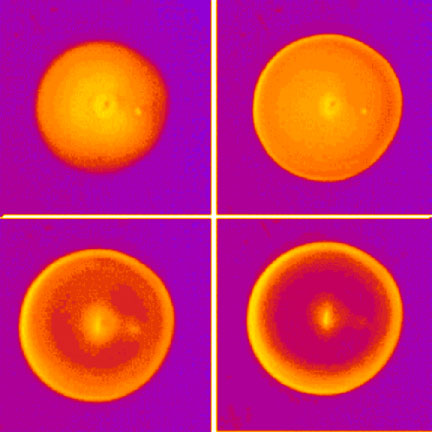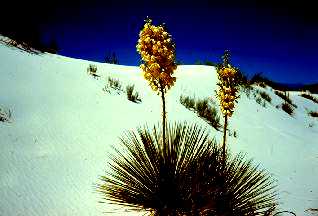Patterns in Biological Systems
Anna Delprato, Azadeh Samadani, Toni Neicu, and Arshad Kudrolli
Read press release at

We use Bacillus subtilis to study pattern formation under a changing environment. The pattern in the figure was obtained 12 hours after innoculating bacteria at the center of a 4.8 cm diameter petridish filled with a thin layer of agar and nutrients (peptone). A circular pattern is observed for low agar and high nutrient concentrations.
 We have investigated the spatio-temporal response of Bacillus subtilis growing
on a nutrient-rich layer of agar to ultra-violet (UV) radiation. We show
that below a crossover temperature, the
bacteria are confined to regions that are shielded from
UV radiation. A forced migration (convection) of the
bacterial population is effected by rotating a rectangular UV
radiation shield relative to the petri dish. The critical
extinction speed at which the bacterial colony lags behind the
shield is found to be qualitatively similar to the front velocity
of the colony growing in the absence of the hostile environment as
predicted by the model of Dahmen, Nelson and Shnerb (cond-mat/9807394). A quantitative
comparison is not possible without considering the slow dynamics
and the time-dependent interaction of the population with the
hostile environment.
We have investigated the spatio-temporal response of Bacillus subtilis growing
on a nutrient-rich layer of agar to ultra-violet (UV) radiation. We show
that below a crossover temperature, the
bacteria are confined to regions that are shielded from
UV radiation. A forced migration (convection) of the
bacterial population is effected by rotating a rectangular UV
radiation shield relative to the petri dish. The critical
extinction speed at which the bacterial colony lags behind the
shield is found to be qualitatively similar to the front velocity
of the colony growing in the absence of the hostile environment as
predicted by the model of Dahmen, Nelson and Shnerb (cond-mat/9807394). A quantitative
comparison is not possible without considering the slow dynamics
and the time-dependent interaction of the population with the
hostile environment.
 We also observed a novel morphological transition in a Bacillus subtilis colony initially growing under ambient conditions, after ultraviolet radiation exposure. The bacteria in the central regions of the colonies are observed to migrate towards the colony edge forming a ring during uniform spatial exposure. When the radiation is switched off, the colonies were observed to grow both inward into the evacuated regions as well as outward indicating that the pattern is not formed due to depletion of nutrients at the center of the colony. We also propose a reaction-diffusion model in which waste-limited chemotaxis initiated by the UV radiation leads to the observed phenomenology.
We also observed a novel morphological transition in a Bacillus subtilis colony initially growing under ambient conditions, after ultraviolet radiation exposure. The bacteria in the central regions of the colonies are observed to migrate towards the colony edge forming a ring during uniform spatial exposure. When the radiation is switched off, the colonies were observed to grow both inward into the evacuated regions as well as outward indicating that the pattern is not formed due to depletion of nutrients at the center of the colony. We also propose a reaction-diffusion model in which waste-limited chemotaxis initiated by the UV radiation leads to the observed phenomenology.
The migration of life in response to a changing environment is a common theme in biological systems. The change in environment may be due to global warming, ground water changes, forest fires or could be as simple action of wind on sand dunes. 
In the White Stone National Monument the Soaptree Yucca grows up to a foot a year to keep its leaves above the slowly marching sand.
Publications
``Swarming ring patterns in bacterial colonies exposed to ultraviolet radiation," A. Delprato, A. Samadani, A. Kudrolli, and L. Tsimring, Phys. Rev. Lett., 87, 158102 (2001) preprint on cond-mat/0101018)
"Extinction transition in bacterial colonies under forced
convection," T. Neicu, A. Pradhan, D. A.
Larochelle, and A. Kudrolli, Phys. Rev. E 62, 1059 (2000)
(preprint on cond-mat).
Contact:
Arshad Kudrolli
akudrolli@clarku.edu
Department of Physics
Clark University
Worcester, MA 01610

